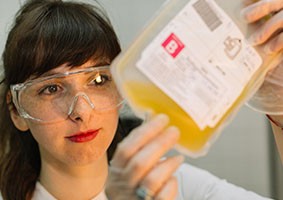Recent Developments in Mitigating the Risk of Bacterial Contamination of Platelets

Title: Mitigating the Risk of Bacterial Contamination of Platelets
Presenters: Michael Jacobs, MD, PhD, and Paul Mintz, MD
Bacterial contamination of platelets (BCP) is a major problem in the United States resulting from room-temperature storage. Initially, there are very few bacteria in a platelet unit. However, the growth medium for bacteria in plasma and the relatively warm temperature allows bacteria to multiply. Common bacterial contaminants frequently achieve levels of 10^8 colony forming units (CFU) per milliliter or more during platelet storage.
To address this, the primary culture of apheresis collections was introduced to the United States in 2004. But numerous studies have demonstrated that apheresis BCP occurred approximately 300 to 400 times per million despite primary culture, which extrapolates to 500 to 700 contaminated transfusions per year in the United States.
Extent and Nature of the Risk
Using data from 195 institutions with surveillance of 1.54 million platelet transfusions, the CDC National Healthcare Safety Network reported 30 septic reactions to platelets between 2010 and 2016. Of these, 14 were severe, five were life threatening, and three were fatal. Apheresis was associated with 26 of the cases, and whole-blood derived platelets were associated with the remaining four.
Similarly, the FDA’s annual reports of transfusion-associated fatalities from 2013 to 2017 documented 10 fatalities related to bacterially contaminated platelets. Apheresis was associated with nine of these deaths, and whole blood-derived platelets were associated with the remaining one.
These reports represent just a fraction of contamination events due to high levels of under reporting as a result of delayed onset reactions and the challenges of relating septic reactions to their actual cause.
While primary culture has effectively removed many of the fastest-growing and most virulent bacterial species, it has not eliminated septic reactions and fatalities. Active bacterial surveillance by culture of platelets at the time of issue is key to understanding the extent of this problem and the effects of interventions.
FDA Final Guidance
Published on September 30, 2019, the FDA Final Guidance:
- Recommends an 18-month compliance period (until March 2021)
- Applies to all blood collection establishments and transfusion services
- Makes numerous recommendations
- Requires the use of FDA-cleared or approved products for compliance
- Requires that the use of these products is consistent with their instructions for use
The Guidance also includes two key clarifications:
- Products may ship during recommended culture incubations provided that control of the product is maintained during the incubation period
- Platelets that have been identified as bacterially contaminated may not be released for transfusion
The FDA describes both one-step and two-step strategies in its Final Guidance, either of which provides up to seven days of shelf life. It also offers three technology choices:
- Culture
- Large-volume delayed sampling for five- or seven-day dating of apheresis platelets in plasma (not yet FDA cleared for seven-day dating
- Secondary culture for five-day dating of apheresis platelets or pre-storage pool
- Secondary culture for seven-day dating of apheresis platelet
- Single whole blood-derived pools for five-day dating - Pathogen reduction for five-day dating
- Applies to leukoreduced apheresis platelets in PAS or plasma - Rapid testing for five- or seven-day dating
- Applies to leukoreduced apheresis in plasma (LRAPs) for seven-day dating or LRAPs in plasma or PAS, pre-storage pooled whole blood-derived samples for five-day dating, and single units and post-storage pools of whole blood-derived platelets
Visit the FDA website to download the full Final Guidance document.
The Role of Rapid Testing
Rapid testing is available for testing all platelet types that require testing under the guidance.
- Requires 500µL sample for any unit type previously tested by early culture
- Recommends the use of a rapid test such as the PGD test within 24 hours of transfusion for five-day dating
- Allows use of a rapid test cleared as a safety measure such as the PGD test on apheresis platelets in plasma within 24 hours of transfusion for seven-day dating
A survey of 16 blood collection centers and 66 hospitals that extend dating to seven days with the PGD test found that:
- Seven-day dating of LRAPs can fully fund all testing and help save money
- There was no impact on split rates due to the small sample size, with reduced need for donor recruiting with seven-day dating
Watch On Demand Download Slides (PDF, 2.3MB)
This webinar is produced by Whitehat Communications, a provider of continuing education programs in clinical laboratory sciences that has been approved by the ASCLS P.A.C.E.™ Program. One P.A.C.E. credit hour will be provided for this complimentary, basic-level program.
Complete the evaluation on whitehat.com to receive your P.A.C.E. credit.
Presenters

Michael Jacobs, MD, PhD
Dr. Jacobs is Professor Emeritus in the Department of Pathology at Case Western Reserve University. He is also Director Emeritus of Clinical Microbiology at University Hospitals Cleveland Medical Center.

Paul Mintz, MD
Dr. Mintz is the Sr. Vice President and Chief Medical Officer of Verax Biomedical, Inc.